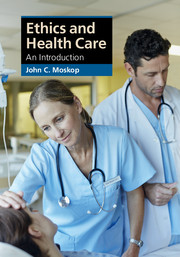Book contents
- Frontmatter
- Dedication
- Contents
- Preface
- Acknowledgment
- Part I Ethics in health care: role, history, and methods
- Part II Moral foundations of the therapeutic relationship
- 6 Privacy and confidentiality
- 7 Truthfulness
- 8 Informed consent to treatment
- 9 Surrogate decision-making
- 10 Professionalism: responsibilities and privileges
- 11 Resource stewardship
- Part III Controversies in health care ethics: treatment choices at the beginning and at the end of life
- Part IV Ethics in special contexts: biomedical research, genetics, and organ transplantation
- Further reading
- References
- Index
- References
7 - Truthfulness
from Part II - Moral foundations of the therapeutic relationship
Published online by Cambridge University Press: 05 February 2016
- Frontmatter
- Dedication
- Contents
- Preface
- Acknowledgment
- Part I Ethics in health care: role, history, and methods
- Part II Moral foundations of the therapeutic relationship
- 6 Privacy and confidentiality
- 7 Truthfulness
- 8 Informed consent to treatment
- 9 Surrogate decision-making
- 10 Professionalism: responsibilities and privileges
- 11 Resource stewardship
- Part III Controversies in health care ethics: treatment choices at the beginning and at the end of life
- Part IV Ethics in special contexts: biomedical research, genetics, and organ transplantation
- Further reading
- References
- Index
- References
Summary
Case example
Twenty-two-year-old Annie was brought by friends to the ED of a small Virginia hospital. She fell while horseback riding, was kicked by her horse, and lay in a field for several hours. Despite initial IV therapy, her blood pressure remains very low, and an abdominal tap reveals that she is bleeding very rapidly into her abdomen.
Though she is in shock, Annie remains awake and alert. She asks Dr. Smith, the emergency physician caring for her, “Is it a serious injury? Will I live?”
Dr. Smith responds, “Everything will work out, Annie. It may be a little rough for a bit, but it will work out.”
“Are you sure?” she asks. “Please, tell me honestly.”
Dr. Smith is very concerned about Annie's unstable condition, and he is unsure how she will do. What should he say to her?
Past and present
In twenty-first-century Anglo-American societies, truthfulness is widely acknowledged as a central professional responsibility of physicians. Professional standards regarding truthfulness have, however, undergone significant change over the past century, and what constitutes truthful communication is still a matter of some controversy. Other cultures, moreover, endorse somewhat different approaches to communication between physicians and patients. This chapter will examine the meaning and justification of truthfulness in the therapeutic relationship.
In an article published in 1903, physician Richard Cabot states the “rule for truth-speaking” he was taught as a Harvard medical student: “When you are thinking of telling a lie, ask yourself whether it is simply and solely for the patient's benefit that you are going to tell it. If you are sure that you are acting for his good and not for your own profit, you can go ahead with a clear conscience.” As this rule illustrates, the medical profession of that era condemned self-serving lies, but approved lies told for the benefit of patients. Notice that the rule authorizes the physician to judge whether truthful or deceptive information will do more good for the patient, and to base his or her disclosure on that judgment.
This rule Cabot cites appears to have persisted well into the twentieth century. In a survey of 200 Chicago physicians published by Oken in 1961, almost 90 percent of the respondents reported that they generally withheld information about a cancer diagnosis from their patients.
- Type
- Chapter
- Information
- Ethics and Health CareAn Introduction, pp. 90 - 100Publisher: Cambridge University PressPrint publication year: 2016

